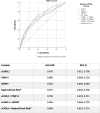Urinary cell cycle arrest biomarkers and chitinase 3-like protein 1 (CHI3L1) to detect acute kidney injury in the critically ill: a post hoc laboratory analysis on the FINNAKI cohort
- PMID: 32276601
- PMCID: PMC7149885
- DOI: 10.1186/s13054-020-02867-w
Urinary cell cycle arrest biomarkers and chitinase 3-like protein 1 (CHI3L1) to detect acute kidney injury in the critically ill: a post hoc laboratory analysis on the FINNAKI cohort
Abstract
Background: Acute kidney injury (AKI) is a frequently occurring syndrome in critically ill patients and is associated with worse outcomes. Biomarkers allow early identification and therapy of AKI which may improve outcomes. Urine chitinase 3-like protein 1 (uCHI3L1) was recently identified as a promising urinary biomarker for AKI. In this multicenter study, we evaluated the diagnostic performance for AKI stage 2 or greater of uCHI3L1 in comparison with the urinary cell cycle arrest biomarkers urinary tissue inhibitor of metalloproteinases-2 (TIMP-2)•insulin-like growth factor-binding protein 7 (IGFBP7) measured by NephroCheck Risk®.
Methods: Post hoc laboratory study of the prospective observational FINNAKI study. Of this cohort, we included patients with stored admission urine samples and availability of serum creatinine at day 1 of admission. Patients who already had AKI stage 2 or 3 at ICU admission were excluded. AKI was defined and staged according to the KDIGO definition and staging system. The primary endpoint was AKI stage 2 or 3 at day 1. Biomarker performance was assessed by the area under the curve of the receiver operating characteristic curve (AUC). We assessed individual performance and different combinations of urine biomarkers.
Results: Of 660 included patients, 49 (7.4%) had AKI stages 2-3 at day 1. All urine biomarkers were increased at admission in AKI patients. All biomarkers and most combinations had AUCs < 0.700. The combination uCHI3L1•TIMP-2 was best with a fair AUC of 0.706 (0.670, 0.718). uCHI3L1 had a positive likelihood ratio (LR) of 2.25 which was comparable to that of the NephroCheck Risk® cutoff of 2.0, while the negative LR of 0.53 was comparable to that of the NephroCheck Risk® cutoff of 0.3.
Conclusions: We found that uCHI3L1 and NephroCheck Risk® had a comparable diagnostic performance for diagnosis of AKI stage 2 or greater within a 24-h period in this multicenter FINNAKI cohort. In contrast to initial discovery and validation studies, the diagnostic performance was poor. Possible explanations for this observation are differences in patient populations, proportion of emergency admissions, proportion of functional AKI, rate of developing AKI, and observation periods for diagnosis of AKI.
Keywords: Acute kidney injury; Biological markers; Biomarkers; Chitinase; Intensive care; Lipocalins; NephroCheck.
Conflict of interest statement
Grants: Author JDL has received a predoctoral grant from the Research Foundation–Flanders (FWO). Author EAJH has received a postdoctoral grant from the Research Foundation–Flanders (FWO) and received speakers fee/travel grant from Sopachem, Astute Medical, Alexion, and AM-Pharma. STV has received a Fellowship Grant from the Sigrid Juselius Foundation and funding for Clinical Researchers (317061) from the Academy of Finland.
Figures
Comment in
-
Current definition of acute kidney injury actually identifies a heterogenous group of patients with elevated serum creatinine and reduced urine output.Crit Care. 2020 May 24;24(1):247. doi: 10.1186/s13054-020-02968-6. Crit Care. 2020. PMID: 32448400 Free PMC article. No abstract available.
References
-
- Kidney Disease: Improving Global Outcomes (KDIGO) Acute Kidney Injury Work Group KDIGO Clinical Practice Guideline for Acute Kidney Injury. Kidney Inter Suppl. 2012;2:1–138. doi: 10.1038/kisup.2012.1. - DOI
-
- Nisula S, Kaukonen KM, Vaara ST, Korhonen AM, Poukkanen M, Karlsson S, Haapio M, Inkinen O, Parviainen I, Suojaranta-Ylinen R, et al. Incidence, risk factors and 90-day mortality of patients with acute kidney injury in Finnish intensive care units: the FINNAKI study. Intensive Care Med. 2013;39(3):420–428. doi: 10.1007/s00134-012-2796-5. - DOI - PubMed
Publication types
MeSH terms
Substances
Grants and funding
LinkOut - more resources
Full Text Sources
Research Materials
Miscellaneous



